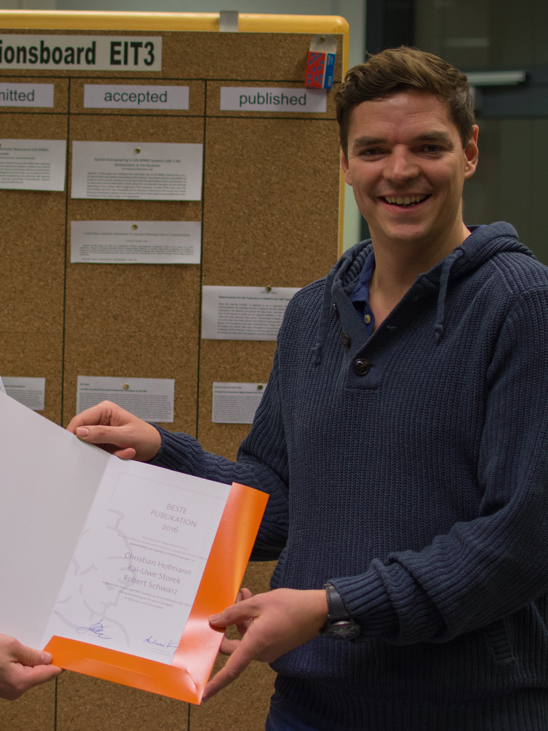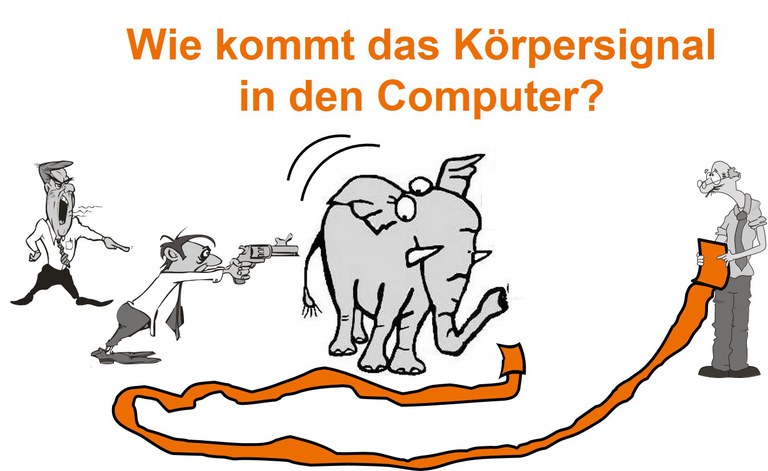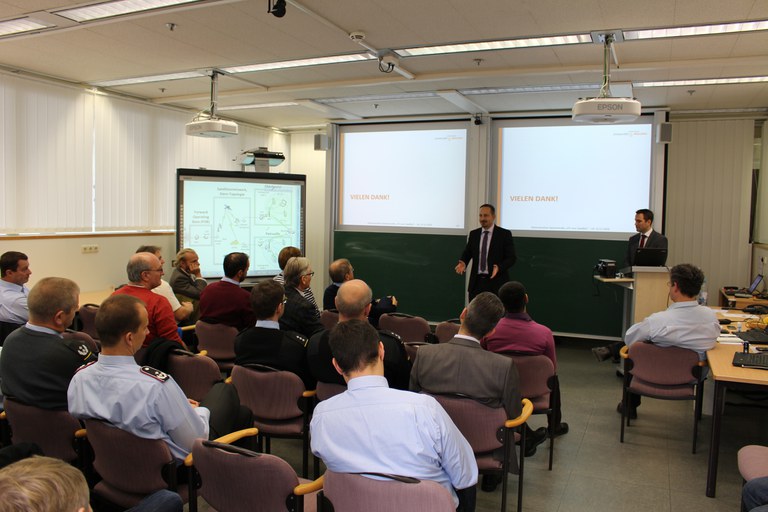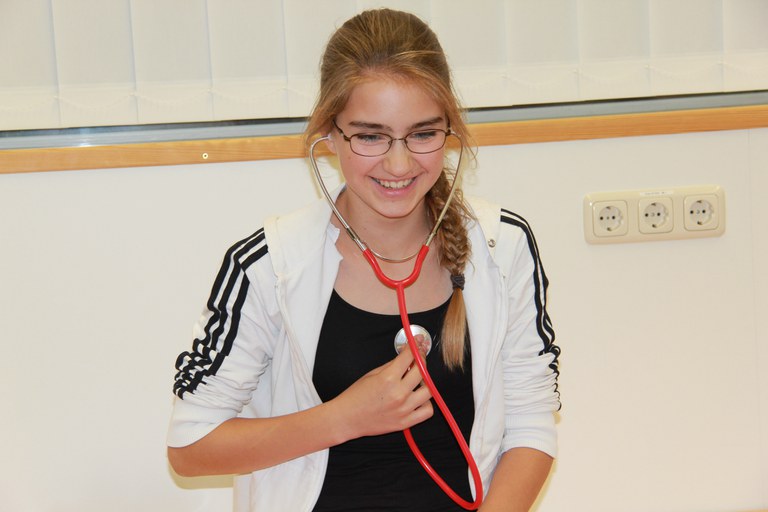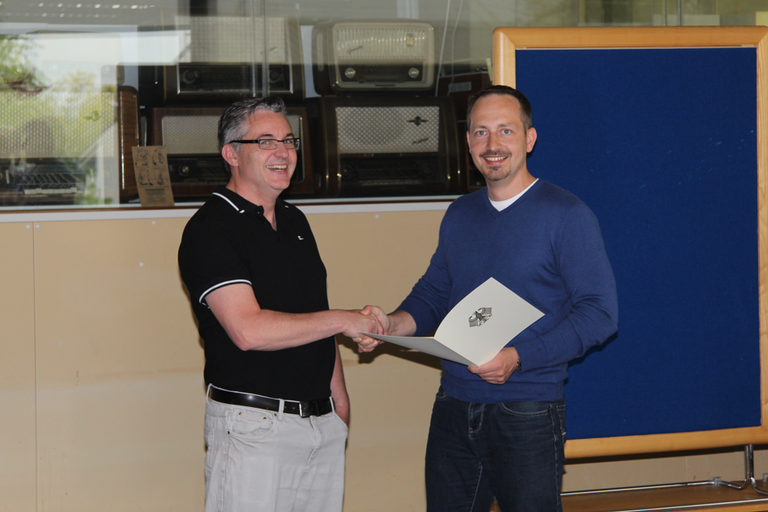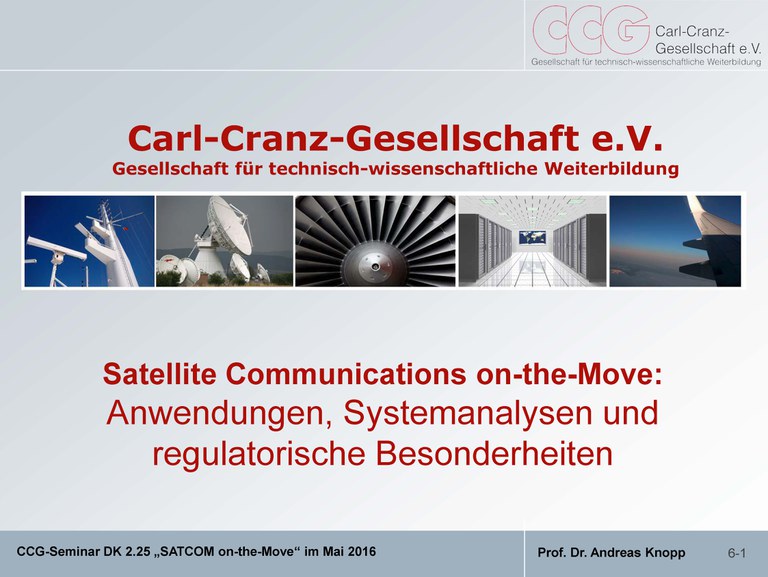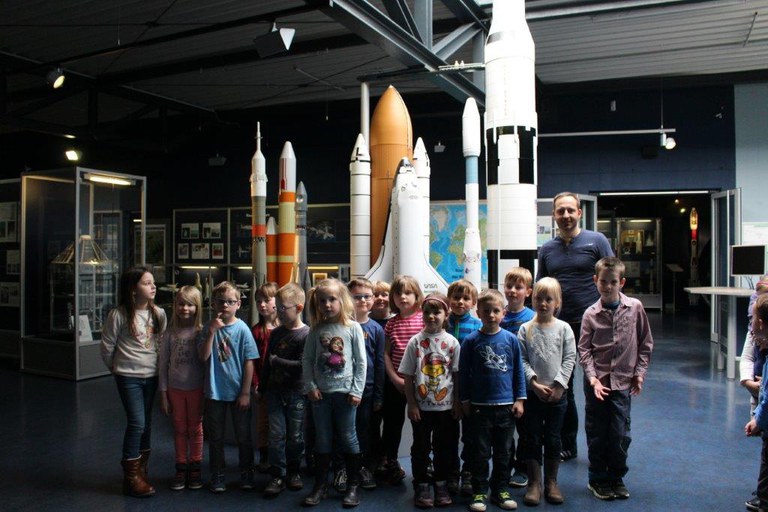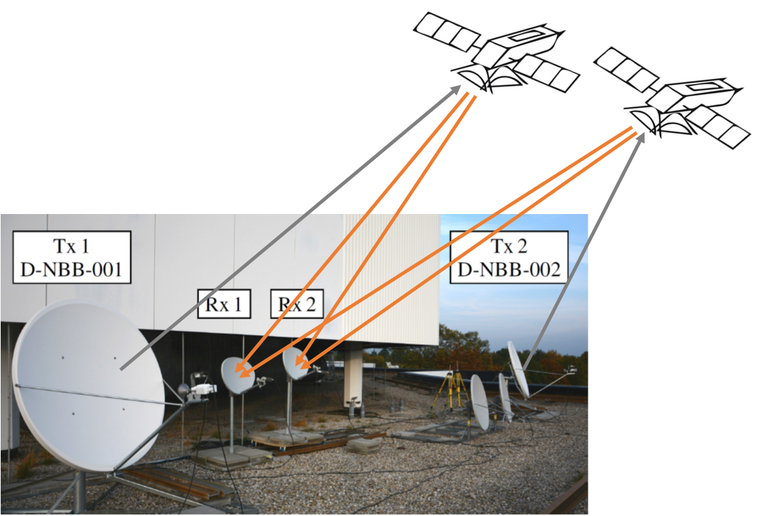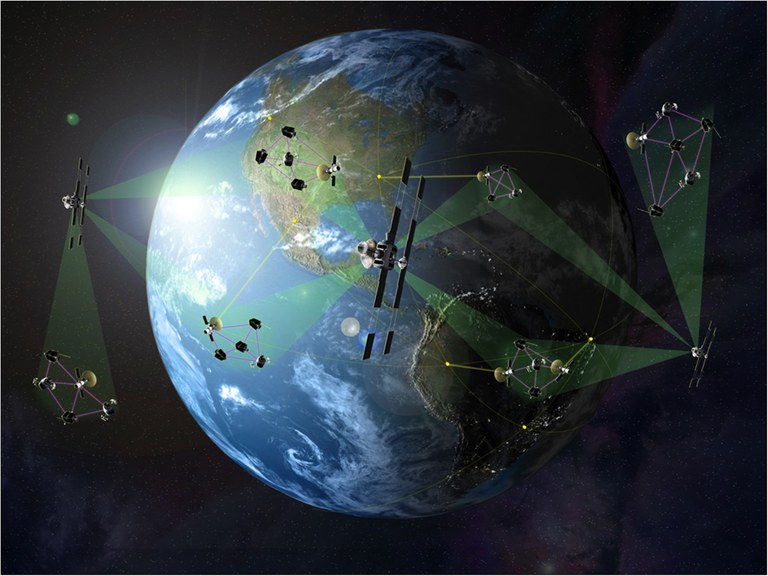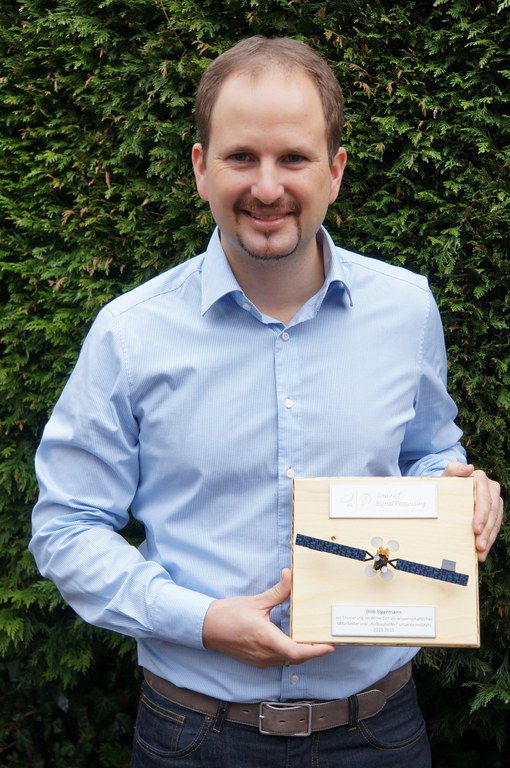| newer News / older News |
|
Best Publication 2016 Award for “Spatial MIMO over Satellite” December 8, 2016: The Institute for Information Technology awarded the “Best Publication 2016 Award” to the authors of the paper entitled “Spatial MIMO over satellite: A proof of concept”. The paper has been written by Christian Hofmann, Robert Schwarz, Kai-Uwe Storek and Andreas Knopp and has been published in the proceedings of the IEEE International Conference on Communications (ICC 2016).
In their publication the authors report the results of a test campaign intended to prove the feasibility of MIMO transmission via geostationary satellites. After several years of theoretical research on MIMO over satellite it has now been possible to confirm the predicted MIMO channel capacity by channel measurements. Accompanied by the world’s first spatial MIMO transmission via satellite the campaign resolved any doubts about the feasibility of this still controversially discussed technology. MIMO is a potential technique to increase the throughput of satellite communications, meeting the abiding demand for higher data rates. The awarded publication has been considered a milestone in research on MIMO over satellite. |
|
Invited presentation at the 24th Annual Meeting of the German Sleep Society December 3, 2016: Together with Thomas Penzel (Charité Universitätsmedizin Berlin) Gerhard Staude chaired the session What I Always Wanted to Know About my Sleep Lab Equipment at the 24.th Annual Meeting of the German Sleep Society (DGSM), held December 1 to 3 at the Maritim International Congress Center in Dresden. The session equally addressed medical doctors and technical staff highlighting the importance of reliable registration of biophysical signals as an essential basis for high-quality diagnostics and medical decisions in the sleep lab. After a short journey through the main components of modern biosignal registration and processing technology, chances and limitations of computer-based detection and classification of sleep stages were critically discussed.
In the first part of his invited presentation entitled How the Biosignal Gets into the Computer - About Electrodes, Wires, Artifacts Gerhard Staude introduced the key elements of the measurement frontend and addressed typical sources of errors corrupting the time-continuous (analog) physical signal. In a second part, he showed how information theoretical knowledge can minimize information loss on the signal’s way from the biological source to its final representation as a sequence of discrete numbers in the computer. |
|
LTE over Satellite Capabilities Demonstration 14-15.11.2016: Having been awarded in 2014 the design and technology study “LTE over Satellite” in order to explore the benefits and drawbacks of a 4G-based core network in a MILCOM environment, the Chair of Signal Processing has successfully demonstrated the first fully operational LTE tactical network that incorporates a long-haul satellite link. Although the LTE standard has always been a prominent candidate for next-generation tactical communications due to its flexibility, scalability and mature technology, the standard finds its origin in cellular mobile networks rather than in military scenarios. In close cooperation with our sponsor BAAINBw (the German military procurement authority) and our project partners Fraunhofer IIS, INRADIOS GmbH and Blackned GmbH, we have now tailored and optimized a military-centric LTE network which not only enables seamless connection and permeable QoS throughout a bunch of communication means like SATCOM on the Move (SOTM) terminals, fixed long-haul satellite links or even legacy equipment, but which also takes into account particular needs for transmission security and eavesdropping as they occur in a military context. In a two-days measurement campaign the capabilities and limits of the network have been demonstrated to an audience of selected military and commercial practitioners from industry and government, who jointly expressed their appreciation for the event due to the timeliness and relevance of the topic as well as the excellent results.
More information can be found here. |
Girls and Technology 2016 August 1-3, 2016: Summer school project “BIOSIGNALS - windows to our body” at the Chair of Signal Processing.
Can we make our thoughts visible? Can we hear our muscles working? Questions like these were addressed by teenage girls between 12 and 14 years who participated in the BIOSIGNALS project during summer holidays 2016. Assisted by staff members the participants enthusiastically mounted electrodes, turned their lunch into bioelectrical voltage generators, registered eye movements, and analyzed heart rates and reaction times. During the three project days the girls proactively experienced a variety of biomedical signal registration and analysis techniques which are used by physicians for clinical diagnosis and employed by scientists for basic research. Registration of cardiac activity (ECG), cerebral activity (EEG), or muscular activity (EMG) are well-known examples. Starting with a brief introduction into basic biological and technical facts, the girls conducted experiments and measurements by themselves, thus getting a tantalizing glimpse into the fascinating field of biomedical information technology. Questions like “Who is the fastest and most accurate fighter against her virtual opponent in the electronic fencing simulation” were examined at least as attentively as the mathematical and technical basics of computer tomography and magnetic resonance imaging technologies. More information can be found here. |
|
Dr. Staude promoted to Academic Director July 1, 2016: Dr. Gerhard Staude, the leader of the Biomedical Information Technology (BIT) research group, has been promoted to Academic Director on June 1st, 2016. The formal act of promotion has been performed by Prof. Knopp in the presence of all members of our institute. In his short laudatory speech, Prof. Knopp pointed out that, being a Director, Dr. Staude has now achieved the highest rank possible in the hierarchy of academic staff, which has been in special appreciation and recognition of his long-term merits for the BIT research group, for our Institute, as well as for the Faculty of Electrical Engineering and Information Technology. We are glad that Dr. Staude will continue as the leader of the BIT research group, having now increased responsibilities and obligations for the development and evolution of this topic and his group.
|
|
Industry Training on SATCOM on-the-move May 10-12, 2016: The Chair of Signal Processing has hosted an industry expert training on “SATCOM on-the-move”, a key technology for future high throughput satellite communications. The annual training, which is organized and owned by the German non-profit education institute Carl-Cranz e.V., comprises ten blocks of lectures on system design, performance analysis, applications, and regulatory aspects. The attendees from different countries represented industry manufacturers and system integrators, military and commercial users, and procurement decision makers. Under the scientific responsibility of Prof. Knopp, four invited lecturers, who are renowned experts in the field of satellite communications, have created a broad and diverse mix of aspects on the topic.
|
|
Children‘s University in the German Spaceflight Museum April 8, 2016: A group of 23 pre-school children has taken part in our excursion to the German Spaceflight Museum (Deutsche Raumfahrtausstellung) which is located in the small town of Morgenröthe-Rautenkranz, the birthplace of Dr. Sigmund Jähn who has been Germany’s pioneer in human spaceflight in 1978. The museum is operated by the German National Aeronautics and Space Research Centre (DLR) and shows historic exhibits of manned and unmanned spaceflights. The chair of signal processing is a member of the museum’s steering association and has organized, co-financed and executed the excursion program. The purpose of the program has been to arise children’s interest and enthusiasm for spaceflight and space projects, as well as to create and increase their curiosity in natural sciences and technology, which are nowadays the basis of Germany’s economic prosperity.
|
First Proof of „MIMO over Satellite“: An Enabling Technology for HTS and MILSATCOM March 9, 2016: The Chair of Signal Processing has successfully performed the world’s first “true spatial” MIMO transmission over two geostationary satellites after years of intense work on the underlying theory and on our unique testbed. The test was run in Ku-Band over two EUTELSAT satellites located on 7 and 10 deg East. At this point we want to thank EUTELSAT for the great support of our field trial. Furthermore, we would like to thank the SMEs INRADIOS GmbH and DIRACON GmbH for their support in hardware manufacturing and line up.
During our test we have been able to demonstrate the linear increase in bandwidth efficiency that can be realized using MIMO. In particular we have doubled the data rate for a given frequency bandwidth and transmit power using two antennas on the ground as well as on the space segment side. This practical success ultimately marks the final step of a research project granted by the National Aeronautics and Space Research Centre (DLR), Space Administration. In the future MIMO will enable the increase of a communication satellite’s data rate by employing multiple antennas transmitting different data streams at the same time and within the same frequency spectrum. Having now proven its feasibility, MIMO will be the most promising, next-generation candidate-technology for High-Throughput Satellites (HTS). Moreover, when using satellites as MIMO satellites, it will be possible to operate co-located satellites with the same coverage in the same frequency band without degrading adjacent satellite interference (ASI). Hence, MIMO might be the technology of choice to pave the way for satellite based broadband internet and video-on-demand (VoD) distribution to numerous households and subscribers. Our calculations show that, using MIMO in combination with contemporary multibeam satellites, it would for example be possible to serve the “last 3%” of German households in rural areas with a single satellite at a very competitive monthly cost-per-Gigabyte-delivered ratio, which can be almost half of terrestrial mobile broadband providers. A further, very interesting market could be commercial aviation where the users can only be served via satellites, but nowadays widespread user acceptance is prevented due to high sales prices for the service. We furthermore address the market of military SATCOM, especially in frequency bands that are densely packed today. A prominent example is UHF tactical satellite radio, where due to very narrow channels of only 25kHz or 50kHz high bandwidth efficiencies are required to serve a sufficient number of users with acceptable data rates. UHF might me especially appropriate for multiple-satellite MIMO because the ground antennas are less directional than in SHF. Proving this in practice will be our next step. |
|
Research on Digital Satellite Payloads February 1, 2016: The Chair of Signal Processing has started a cooperation with Backnang based TESAT Spacecom GmbH, a world leader in equipment and technology for advanced communication satellites. The cooperation focuses on research and development of digital satellite payloads and their components. As a first project the development of adaptive filtering components for various parts of the satellite onboard signal processing chain has been envisaged. This project will been sponsored by the German Space Agency (DLR). Digital satellite payloads are essential for the next generation high-throughput satellite networks, which are expected to serve thousands of users in unicast, offering a terabit throughput for internet and multimedia applications.
|
New job opportunity for Dirk Ogermann January 1, 2016: After almost three years of active research Mr. Dirk Ogermann leaves our institute to take on new challenges as a system architect in the German defense industry. Mr. Ogermann has been among the first SATCOM researchers at our institute, and he has contributed major achievements to our research group. We owe it very largely to him and his commitment that today we operate an unmatched SATCOM test infrastructure here at UniBwM. Moreover, Mr. Ogermann has contributed a lot to the experiments we use in engineering education. Further achievements of Mr. Ogermann comprise more than 10 scientific conference publications and several active contributions to NATO’s SATCOM working group. In his time at our institute, Mr. Ogermann has developed to an expert in military tactical communications with a special focus on LTE networks and LTE-SATCOM network integration. This rare knowledge has made Mr. Ogermann being a highly sought-after expert for the national defense industry. Although we regret losing a valued colleague, we are happy and proud that our research is valued by our industry partners, giving our research assistants excellent job perspectives. We would like to thank Mr. Ogermann for his great work and wish him all the best for his future career!
|
| newer News / older News |
News 2016

